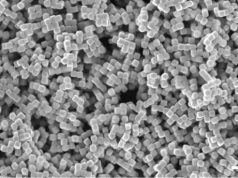The maiden flight of The Delta took place on 19 March 2016 at the Sungai Rambai Aerodome in Malacca, in neighbouring Malaysia. The Delta is the lightest aircraft in the world that can take off and land with wheels while carrying an adult pilot.Credit: Image courtesy of National University of Singapore
NUS students tackle engineering challenge from National Geographic Channel and custom build lightweight aircraft inspired by paragliders and tricycles
A team of eight engineering students from the National University of Singapore (NUS) have successfully designed and built the world’s lightest electric paraglider trike, dubbed The Delta. The aircraft has two rear-mounted propellers, horizontally arranged, each driven by a motor and is powered by Lithium polymer batteries. It is the lightest aircraft in the world that can take off and land with wheels while carrying an adult pilot. The NUS team envisions this as a safe, clean and simple way to realise our dreams of flying.
The electric paraglider trike was built under the auspices of FrogWorks, a design and prototyping studio for green vehicles founded by and for NUS students in the Design-Centric Programme (DCP) at the NUS Faculty of Engineering. The Delta follows FrogWorks’ previous wildly successful personal flying machine named Snowstorm, which was recently exhibited at the Founders Forum in London. Other FrogWorks projects include the conversion of a sport motorcycle and a yacht from petrol to electric propulsion.
The Delta was specially built for the National Geographic Channel’s new series “Machine Impossible.” The programme’s producers had approached DCP with a challenge to build a flying vehicle for their show. The vehicle could take any shape or form, as long as it flies, fits the budget, and most importantly, is a lot of fun to fly. The NUS team gamely took up the challenge and decided to build an electric paraglider trike. The “Machine Impossible” episode featuring The Delta aired on 28 July 2016, 9.00pm Singapore Time, on the National Geographic Channel. Repeat telecast will be on 30 July 2016, 7.00pm Singapore Time.
“The challenge in designing and building The Delta was three-fold: we had to find the lightest airfoil possible, a wing, blade or sail crucial for flight, which we found in a conventional cloth paraglider; we had to find the lightest motors to provide enough thrust for The Delta to be airborne; and we had to build it so that it is light enough to fly yet sturdy enough to be safe,” explained Dr Rangarajan Jegadeesan, one of the project supervisors from DCP and a lecturer at the Engineering Design & Innovation Centre, NUS Faculty of Engineering.
Find your dream job in the space industry. Check our Space Job Board »
The Delta’s features and capabilities
The Delta weighs just 49 kilogrammes, and is capable of carrying one person up to 75kg. In its current prototype, The Delta can fly up to a speed of 36 kilometres per hour under normal wind conditions, and for a typical flight time of 10 minutes on fully-charged batteries. This allows it to cover up to a distance of 6 kilometres.
The NUS team designed and built The Delta over three months from January to March this year at a workshop in NUS Faculty of Engineering.
“Designing and building The Delta was an experience like no other. We had a great learning experience as we went about tackling various aspects of the project, from constructing the physical frame to designing and implementing the aircraft’s electric energy system and pilot safety system. It was an engineering challenge we greatly relished,” said Mr Chan Wai Yang, a Year 3 engineering student at NUS.
The Delta’s form is simple, minimalistic, yet sturdy — it has a chassis with wheels and steering, a seat for the driver, two electric motors, two propellers, and it incorporates an off-the-shelf paraglider. The NUS team custom built The Delta’s chassis, which includes a frame made from aluminium with carbon fibre connections — materials chosen for their strength and lightweight nature. The Delta has three wheels, where its two back wheels are supported by fiberglass rods suspension, while the front wheel is connected to the steering — an inspiration that the team took from the familiar children tricycles.
The Delta’s propulsion is provided by two 8 kilowatt brushless electric motors, arranged horizontally behind the pilot. Each motor drives a 31-inch propeller. Two 14S Lithium polymer batteries provide the electricity needed to power the motors. The paraglider attached at the back of The Delta provides the lift required for upward takeoff as it catches the wind when the aircraft moves forward.
The NUS team also designed several features to ensure the safety of the pilot. This includes a roll cage to protect the pilot, fiberglass rods to cushion the landing, barrier nets between the pilot and propellers, and engine kill-switches for the pilot in case of an emergency.
The maiden flight of The Delta took place on 19 March 2016 at the Sungai Rambai Aerodome in Malacca, in neighbouring Malaysia. The flight was successful at the first try. The Delta takes off in a similar fashion to conventional aircrafts — the motors power the propellers, which propel it forward. The propellers also generate sufficient draft to fully engage the paraglider’s parachute at the back. Once The Delta gains speed of around 30 kilometres per hour, it takes off.
“We are thrilled to have this opportunity to build an all-new machine for the National Geographic Channel. Designing and building The Delta allowed us to push the limit of our creativity and engineering know-how, while building upon our experience from previous successful FrogWorks projects. We will continue to fine-tune The Delta, and at the same time, we also look forward to creating more sustainable recreational vehicles, be it on land, at sea or in the air. Such projects have tremendous values in the education of our students in Engineering,” said Associate Professor Martin Henz, project supervisor and advisor at the DCP at NUS.
Source: National University of Singapore











